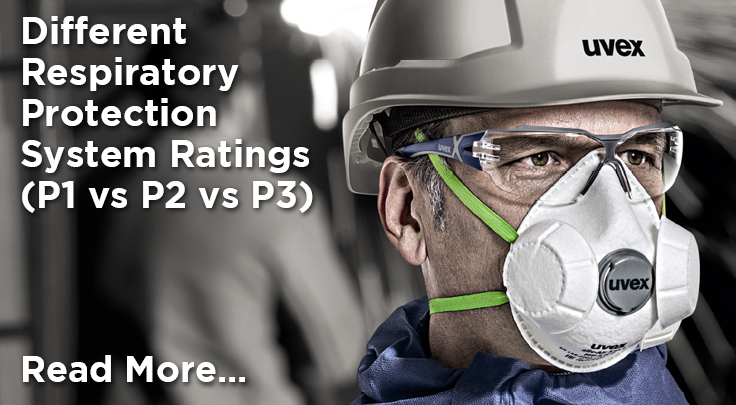Different Respiratory Protection System Ratings (P1 vs P2 vs P3)

Respiratory protection refers to personal protective equipment (PPE) that protects the wearer from airborne particulates and environmental pollutants. Respiratory protection for particulates is used in many industries including pharmaceutical, construction, quarrying, agriculture, foundries, architectural masonry, and recycling.
The key to proper protection is selecting the right respirator mask for you. Regardless of how good the respirator fits it is unable to filter out the hazards that it is not designed for, and conversely a poorly fitted respirator is nearly useless.
To make the selection easier, respirator masks are divided into different ratings based on the levels of particle protection they offer and the type of environment they’re suitable for.
Particulate protection is split into three categories, P1, P2, and P3. Below is an overview on each.
P1 Respirators
P1 respirators protect against mechanically generated particles. P1 respirators are commonly recommended for workplaces with low levels of dust. Workplaces where hand sanding, cutting, and drilling is done are all potential users of P1 masks. These masks can protect the users from liquid and solid aerosols. It filters at least 80% of airborne particles.
P2 Respirators
P2 respirators offer protection against mechanically and thermally generated particles. As compared to P1 masks, P2 masks offer higher protection. They are ideal for workplaces that involves sanding, cutting and drilling with moderate dust levels. P2 respirators protect against low toxic fine dust up to 10 times the acceptable limit.
P3 Respirators
Similar to P2 respirators, P3 masks also offers protection against mechanically and thermally generated particles. Workers who handle hazardous powders like the ones that are used in the pharmaceutical industry generally use P3 masks. They are also recommended for workplaces where the workplace hazard is not correctly known.
Selecting the Right Respiratory Protection Mask
As mentioned above, choosing the right respirator is key. No matter how well made your respirator is, it cannot filter out hazards that it’s not designed for. Once you have the results of your exposure assessment, you are ready to select appropriate protection for your employees. To select the right respirator mask, follow the steps below:
Step 1: Determine your level of hazard.
Step 2: Find out if your workers need respiratory protection.
Step 3: Establish the level of protection needed.
Step 4: Choose a respirator type.
Respirator masks are a simple yet highly effective strategy to protect yourself against airborne particulates which can lead to wheezing, cough, chest tightness, shortness of breath, breathing difficulty, and even life-threatening long-term conditions.
Assess and identify the airborne hazards of your workplace to ensure you are using the correct mask. If in any doubt, always go with the mask that offers the highest level of protection.
Southland Supply Group
Southland provides a wide selection of respiratory protection masks that can help protect against chemicals as well as particulate hazards, including oily mists. Our respirators are available in different brands like 3M, Scott Safety, MaxiSafe, SafeTek Get Protected, Sundstrom, Uvex and more. Browse our range of respirator masks online today.
